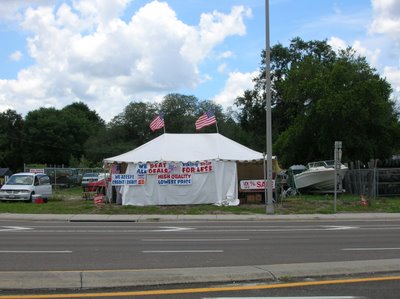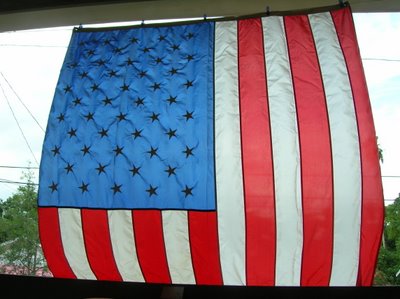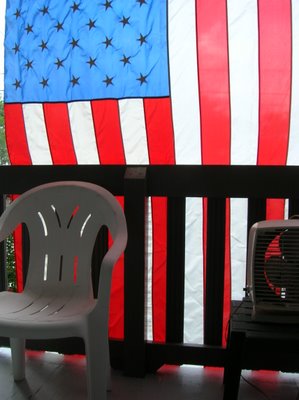12.19.2018
8.17.2015
12.02.2008
The day the Amarillo Ramp got painted.

The Amarillo Ramp is an earthwork designed by Robert Smithson and constructed on property owned by Stanley Marsh just outside of Amarillo, in Potter County, Texas. In 1973, Smithson selected the site and staked out the shape of the ramp, but was killed in a plane crash while viewing the site in advance of construction. The ramp was completed later that year under the direction of Richard Serra, Tony Shafrazi, and Nancy Holt (Smithson’s widow). The ramp originally conceived and constructed to sit at the edge of Tecovas Lake, an impoundment of Tecovas Creek, which itself flows into the Canadian River about five miles north of the Ramp site. The dam which formed Tecovas Lake has failed in the years since the ramp was constructed, leaving the site dry and some distance from the main flow of the creek.
The ramp is a semicircle 150 feet in diameter and open to the northeast. It rises in a clockwise direction from the grade of the dry lakebed to a high point of approximately 10 feet. The ramp is clearly visible on Google Earth and other online aerial image servers. Its coordinates are 35° 22’ 30.33” N, 102° 01’ 47.31’ W. Online topographic maps at Terraserver.com, dated from 1966, show the former extent of Tecovas Lake.
Photos of the ramp from the 1970s show it as a bare pile of earth jutting out from the water, or against a dry and barren lakebed. In 2007, the lakebed had reverted to grassy rangeland and volunteer plants had sprouted on the ramp itself.
Head of Amarillo Ramp, viewed from within the semicircle.
 Danielle climbing the spine of the ramp.
Danielle climbing the spine of the ramp.Ground detail, Amarillo Ramp.

Ants reside in the Amarillo Ramp.

Cattle graze on and around the Amarillo Ramp. Cows and ants assist entropy, I suppose.

The Ramp is on property owned by Stanley Marsh, about sixteen miles northwest of downtown Amarillo. The road to the ramp passes a helium extraction facility. Helium extraction is an important industry in Amarillo.

Visiting the Amarillo Ramp requires a rather bumpy ride over unpaved ranch roads.

While the lake has been dry for some time, pipes and pumping equipment that once pulled water from the lake are still visible. An article by Eugene Tsai, in the exhibition catalog, Robert Smithson (2004, Museum of Contemporary Art, Los Angeles), claims that Smithson chose the site at Tecovas Lake, in part because he was “intrigued by its unique system of irrigation.” This pumping equipment is visible in a photo of Smithson and Stanley Marsh visiting the site, published on page 31 of the catalog.


A breach in the dam which once held inTecovas lake can be seen to the left of the center of this
image.

The breach in the dam is a preferred route for the cattle to move around the ranch.

Rock formations near former Tecovas Lake, outside Amarillo Texas.

LBK chose the day of our visit as an opportunity to realize a "project" he had been thinking about for some time: painting some of the rocks in the Amarillo Ramp.

I’m still not sure what to think of his intervention. Part of me accepts it as another manifestation of entropy. Earthworks are so often understood as static and inviolate objects. I need to read a lot more of Smithson’s writing, but I believe his interest in entropy allows for the eventual decay of all structures. Does it matter if decay is occasioned by human efforts rather than forces of ‘natural’ origin, such as erosion and atomic-level decay? Would ants be considered natural and grazing cattle cultural? Then again, a coat of paint is usually deployed as buffer against decay. Will these few rocks persist on the site longer?
I suppose the disturbing part, in a cultural sense, is this act’s “violation” of a work of art by a famous artist. This particular piece carries some additional weight, perhaps, because the artist died in the process of developing it. Then again, it was executed posthumously by his associates. I know the lines of authorship are very blurry in the practice of contemporary art; I wonder how much that matters here.



One of the items highlighted was a survey stake, which was perhaps placed by Smithson in designing the ramp.

Danielle found a metal object resembling a minnow can as we walked nearby. She arranged a few flowers in it and left it there.
 Amarillo Ramp, July 12, 2008. Pre-painting (top) and post-painting (bottom).
Amarillo Ramp, July 12, 2008. Pre-painting (top) and post-painting (bottom).







































